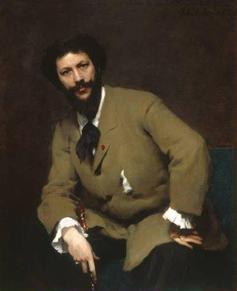 Born in 1847, painter and art critic Robert Alan Mowbray Stevenson (a cousin of Robert Louis Stevenson) In 1873 Stevenson studied at the Ecole des Beaux-Arts then under Carolus Duran (pictured left). He wrote the classic book Velasquez in which he discussed the nature of the purely pictorial appeal of the painter's art. The final chapter of the book, in particular, has some fascinating insights into the philosophy of seeing which is at the core of much modern representational painting. These excerpts give an indication of Stevenson's conception of the importance of the visual impression in Velasquez's work - his views having been informed during his time studying with Duran: "The modern painter should concern himself very much about what seems and scarcely at all about what is." "Twigs, stones, slates, grass, leaves, can only be suggested; an attempt to define them really could result in nothing but a coarse travesty, which must inevitably lessen the effect of the more important markings." "Those who have not been taught from the beginning in an impressionistic school must remember difficulties which beset them when they were working from nature, and will recall how they only began to appreciate the meaning and the necessity of working from a single impression. How often it seemed impossible to finish a picture. The more closely they applied themselves to study and complete a part, the more it seemed to change to their eyes, and to invalidate their previous observations... Now, all of his separate observations may have been true, but they were all made under different conditions of attention to the scene; whereas, until every part of the picture has been observed in subservience to the impression of the whole, completeness can never be even begun." "A shadow on the yellow sand will alternately seem cold or warm, blue or orange, according to the concentration or diffusion of the sight...When a shadow is looked at alone it appears more full of colours than when the surrounding sunlit parts of the view are taken in and are allowed to operate on the shadow."
0 Comments
Leave a Reply. |
Ben Laughton SmithContemporary works of art in the classical tradition. Archives
March 2021
Categories |
Proudly powered by Weebly
 RSS Feed
RSS Feed